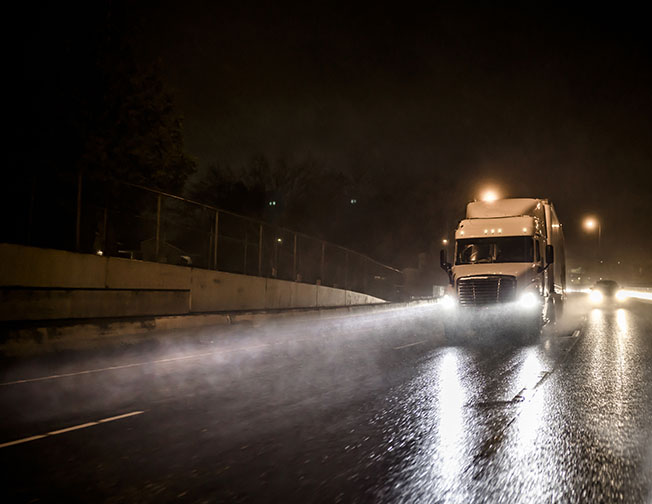Here’s a word of advice for truck drivers who hold concealed-carry permits in their home states to consider before carrying a firearm on the road: Arm yourself with knowledge before arming yourself with the gun of your choice.
With no national law specifically addressing the right of truck drivers to carry firearms, drivers must abide by state laws along their routes. And because there is no readily available, well-versed source of information on the varying state laws, gun-toting drivers could find themselves in deep legal trouble if caught with a firearm in the wrong state. In fact, if you can afford to hire a well-versed gun-law attorney to ride shotgun, it’s likely worth the investment.
A recent survey of truck drivers revealed that 73% of respondents have been in a situation where they did not have a firearm available but wished otherwise. That’s not to say they would have actually used said firearm; rather, having one within arm’s reach would have made them more comfortable.
However, driving with a firearm in tow is risky business. Whether you are a company driver or an owner-operator, knowledge is your best friend when choosing a method of self-defense for a given route. Packing a handgun or any other firearm may offer a sense of personal safety, but without knowledge of firearm laws, which vary with the crossing of every state border, your concerns about self-defense might be related to your cellmates instead of roadside assailants, and you can be sure you won’t have a firearm available behind bars.
Begin with your carrier’s policy
“A majority of carriers prohibit drivers from having firearms with them in the cab of their trucks,” said David Heller, vice president of government affairs for the Truckload Carriers Association.
Before arguing that such a company policy violates state law or your Second-Amendment rights, realize you’ll be fighting a losing battle. To date, courts have not issued a ruling that says the Second Amendment applies to the workplace. The bottom line is that you are bound by your employer’s policy. If your carrier says drivers cannot carry firearms in its trucks, you’ll be instantly unemployed when your boss realizes you are packing while driving.
Most likely, your employer is concerned for your safety. In general, carriers simply prefer to use options other than firearms when it comes to drivers’ protection.
“One way carriers keep drivers safe in lieu of allowing them to carry firearms is through communication,” Heller said.
We’ll discuss communication and other safety options in Part 3 of this series. For the time being, unless you’re an owner-operator, chances are that your employer is unlikely to allow you — or any other driver — to travel with a firearm in tow.
Concealed-carry reciprocity between states
When it comes to carrying firearms for personal protection, owner-operators have the freedom of choice — but an uninformed choice is not a good one. Drivers need to learn about the gun laws of each state along their planned route. Access to updated information regarding guns laws and concealed-carry reciprocity between states is vital. But the patchwork of state laws makes for complicated planning and can lead to lengthy delays that are sure to cost you not only time but also money — money in the form of unpaid contracts and fines for violating state laws.
“Contracted drivers need to be aware of the varied state laws related to firearms,” Heller said. “It comes back to knowledge. Drivers need to know where they are and know the laws.”
Much of the knowledge Heller refers to involves route planning. If certain states have laws prohibiting out-of-state drivers from carrying firearms, alternate routes need to be considered. Even then, finding a legal route between points may not only be difficult; it could be impossible.
An extreme but very real example

Let’s consider a Vermont-based driver headed for Kentucky or vice-versa. Both states are similar in that they are “constitutional-carry” states; that is, the laws of both states recognize an individual’s freedom to own and carry a firearm (with some restrictions). Armed with that information, one might think traveling between the two states with a firearm is a matter of just hitting the road. Nothing is further from the truth.
A quick glance at a map showing reciprocity of concealed carry permits between states shows the first problem — New York, a state with gun laws that are among the strictest in the nation. Pennsylvania’s laws may also create problems when carrying a firearm and traveling between Vermont and Kentucky, but the most obvious issue is New York. One cannot leave or enter Vermont (except to Maine and New Hampshire) without crossing New York. If you carry a firearm for personal protection, you’re out of luck. The Federal Firearm Owner Protection Act (FOPA) offers provisions allowing to transport firearms, but the requirements defeat the purpose for truck drivers. Under FOPA, a firearm must be unloaded, not readily accessible and carried in locked storage. Because of this, if a criminal attacks a sleeping driver, a firearm carried under FOPA regulations will not be of much use for self-defense.
The Vermont-New York-Kentucky route is but one example of how state laws impact truck drivers’ ability to carry firearms for self-protection. State laws are as varied as the states. And don’t try to include Canada in your route to bypass state laws. Canada bans some categories of firearms and severely restricts others. Unless you’ve taken steps to ensure your firearm is legal to carry across the border, be prepared to pay a heavy fine or spend some time in jail if authorities happen to spot your firearm.
Luxury may not be worth the cost
If you are an owner-operator and have the luxury of choice when it comes to carrying a firearm on the road, think twice. Make sure you are armed with knowledge before choosing to pack. And take Heller’s advice before heading out on the road: Familiarize yourself with the laws in your state, your destination’s and every state in between. You may find the luxury of personal choice more of a burden than a carrier’s policy prohibiting firearms in its vehicles.
Check back tomorrow to read the last installment of this three-part series about violence against truck drivers and self-protection. we’ll take a look at how carriers work to keep their drivers safe and how some drivers protect themselves by means other than firearms.
Editor’s note: The Trucker recommends that any driver looking to learn about the legalities of carrying a firearm in their truck should defer to their company’s policies and state, local and national guidance. This article is only an overview and is not meant to be taken as legal advice regarding carrying a firearm in a commercial vehicle.
Since retiring from a career as an outdoor recreation professional from the State of Arkansas, Kris Rutherford has worked as a freelance writer and, with his wife, owns and publishes a small Northeast Texas newspaper, The Roxton Progress. Kris has worked as a ghostwriter and editor and has authored seven books of his own. He became interested in the trucking industry as a child in the 1970s when his family traveled the interstates twice a year between their home in Maine and their native Texas. He has been a classic country music enthusiast since the age of nine when he developed a special interest in trucking songs.








I would like a breakdown of the various state requirements for concealed carry holders as you did for NY